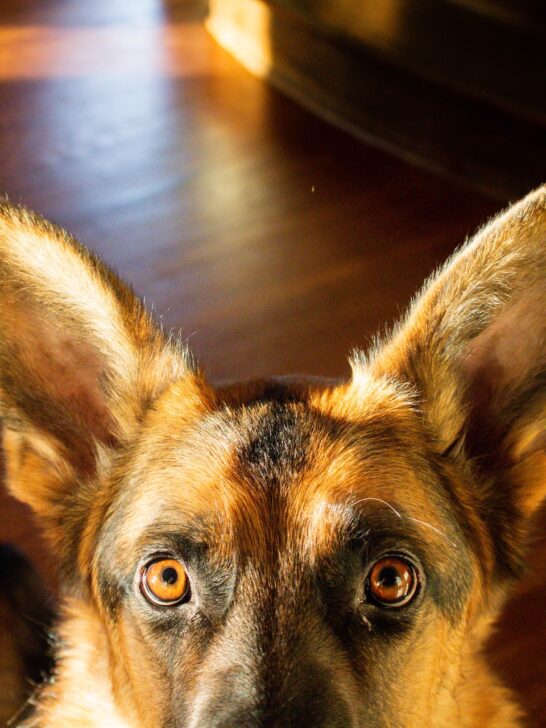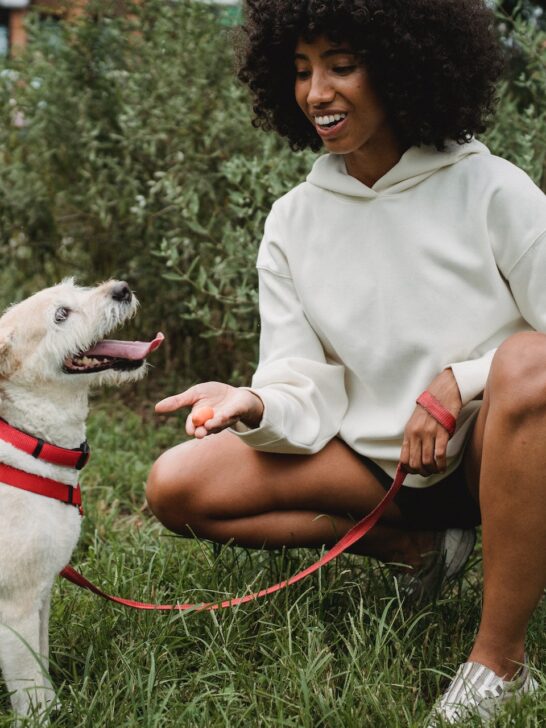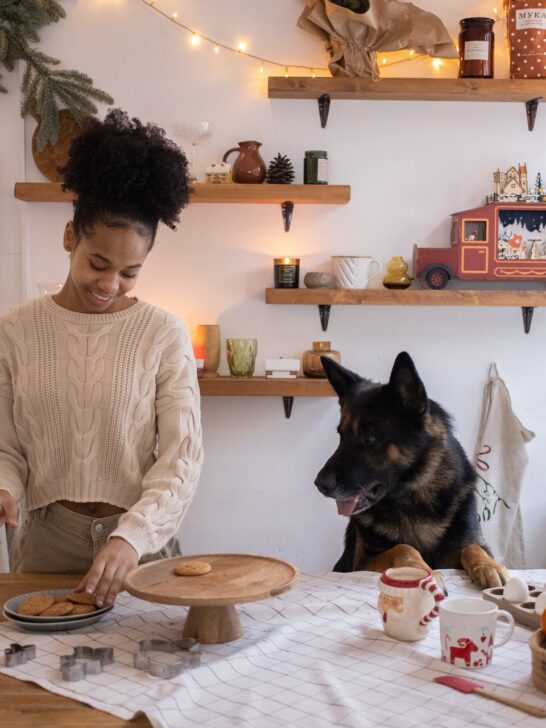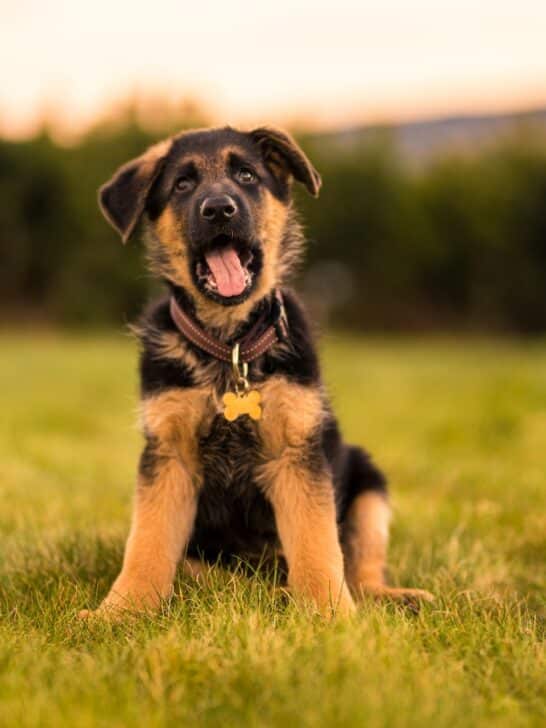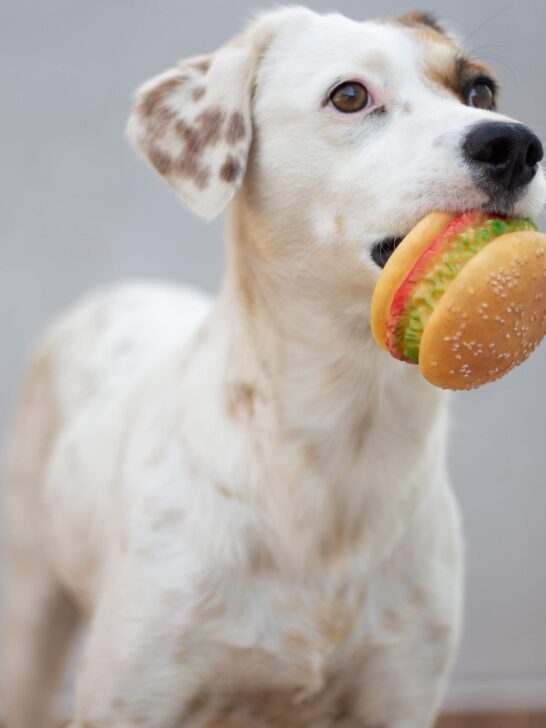5 Best Ways to Cut a German Shepherd’s Nails
You already know the importance of keeping your dog’s nails short and paws healthy.
Does the thought of trimming your German Shepherd’s claws conjure images of tackling and wrestling with your dog across the living room?
Are you embarrassed to take your Shepherd to the groomer?
We go over several ways of how to cut German Shepherd nails and keep your sanity.
All dogs, including German Shepherds, have two major parts to their nails.
However, on top of avoiding cutting the inner area of the nail, you also must work around the highly sensitive paw.
Approaching nail trimming both as a training exercise and an organization test will enable you to make the process more efficient for yourself and more tolerable for your dog.
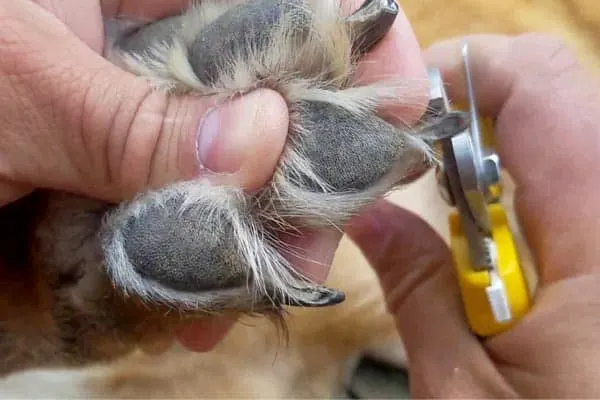
What is special about a German Shepherd’s foot?
A German Shepherd should have large, round, strong paws. As is true with many dogs, the GSD carries most of its weight on the front end.
Since 60% of a German Shepherd’s bulk is in front of the last rib, the front paws are slightly larger than the rear feet.
However, during movement 70% of the power of a German Shepherd comes from the hind end muscles, so the rear claws will wear faster than the front.
Canine nails, or claws, grow from the tip of the bones of the paw. Similar to your fingers and toes, the phalanges have three bones each.
The last bone segment has the base of the claw embedded around the tip.
Another way to look at the dog’s claw is to picture a small bone shaped like a small tooth or crescent at the tip, and the nail extends from it.
Dog’s claws are hard but are comprised of the fibrous protein keratin, according to dogcare.dailypuppy.com.
Similar to your nails, a dog’s claw has an outer hard area called the shell and an inner soft area, the cuticle. The major difference is the nail’s shape.
When you look at a dog with white nails, you can easily see the delineation where the quick ends within the shell.
Many German Shepherds have black nails, making it very difficult to tell where the sensitive basal part of the claw ends and where you should make your cut.
Why should you avoid cutting the quick?
A German Shepherd’s quick has not only blood vessels but also nerves. Have you ever had a hangnail?
Imagine your dog suffers the same kind of pain when you “quick” her as you do when you try to rip that hangnail off.
Moreover, the nail will likely bleed profusely even if you just nick the cuticle.

Why do German Shepherds hate having their feet touched and/or nails trimmed?
There are several reasons why your dog may have developed an aversion to you trimming his nails.
Pain
If your dog learns to associate pain with you touching his feet, trimming his nails will always be a nightmare.
- You or someone else has cut his quicks in the past
- Joint pain
- Foot injury
Ticklish
Feet are tactile for dogs like they are for people. If your dog never becomes accustomed to you handling her feet, she may be uncomfortably ticklish.
Dominance Issues
While behaviorists like vetmed.ucdavis.edu feel true dominance aggression is rare in dogs, experts have implicated German Shepherds in several cases.
So you can understand what it might mean to a strong-minded GSD when you take it upon yourself to grab his foot and then attempt to firmly secure it.
Another compelling reason a Shepherd may not appreciate you grabbing an extremity is that fighting dogs will attack the legs to disable their opponents.
While Bully breeds often go for the neck and jugular vein, per NCBI, when they have serious intent to cause harm, Shepherds and other herding breeds may aim for the legs.
Fear
While German Shepherds should never be fearful, some family lines are exactly that.
They may react with anxiety if you crowd them in an attempt to restrain them for a nail trim.
You may have your dog in a bear hug, which makes her uncomfortable, and then you grab a leg.
Even a well-adjusted dog might find this kind of hugging and grabbing behavior rude.
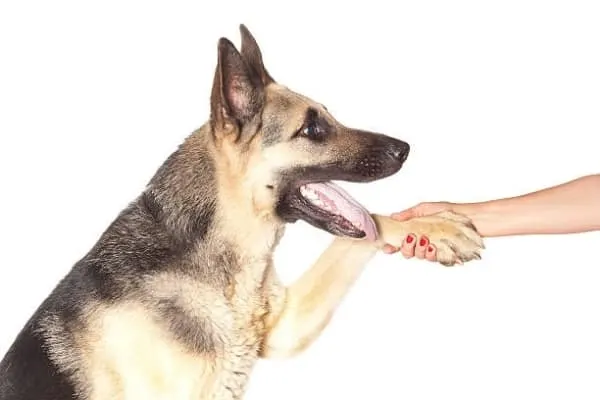
What steps should you take to trim your German Shepherd’s nails?
Get your dog accustomed to having her feet touched.
You should prepare your puppy for her first nail trim way before you ever get the clippers out.
When you have petting sessions, handle your dog’s feet every day.
Start with very brief sessions and gradually increase the contact.
Start when your puppy is very young and use plenty of rewards that can take the form of praise, treats, and playtime.
When you tackle trimming your Shepherd’s nails for the first time, slow and steady wins the race. Bring plenty of positive energy and reinforcement.
If you only cut one or two nails per session, consider that an accomplishment as long as you can keep your pet relaxed and cooperative.
With some German Shepherds, you can approach nail trimming as any other training exercise.
A good idea from a few behaviorists who perform biting drills is to train an undesired behavior for a few minutes immediately followed by the desired activity.
For example, a trainer would put a Shepherd through a few obedience commands and then go to some bite work.
You would cut a few nails, maybe even an entire paw, and then go for a walk or play ball.
Collect all of your equipment.
You want your German Shepherd to view a nail trim as a necessary but efficient process.
You will lose brownie points with your dog if you secure her and then have to run around fetching your tools. If the table is portable, set it up.
In addition to nail clippers, you need powder designed to stop any bleeding in case you catch a quick. You may require a leash and a muzzle.
Tools You Need
Type of Nail Trimmers
- Scissor-type – Great for puppies, may not be strong enough for large adults
- Plier-style – Easy to grip
- Guillotine – Must be precise in your placement; not good for dogs who move a lot; may not work well for black nails
- Grinder – A Dremel tool shortens the nail gradually by filing the surface. These tools work on electricity or battery, and you can use them for primary nail care or after a nail trim with clippers. The handler must be proficient and have a steady hand.
If you want to know more about nail clippers, Here is a list of the 10 Best Nail Clippers For German Shepherd you can find on the market.
This video demonstrates several points. First, the dog is wearing a muzzle for the owner’s safety and to give the dog the signal that he is not in control.
Ideally, this dog should also be restrained because as the handler indicates, the Shepherd can still bite. However, the handler is also gaining the dog’s trust.
Some trainers advocate always using a muzzle during procedures like nail trims as a precaution and to provide a sensory distraction, much like a table would.
You can see the Dremel in use. Many dogs tolerate grinding much better than cutting their nails.
If you could not maintain this dog’s respect as effectively as this owner could, this Shepherd would be a prime candidate for professional intervention.
Finally, the owner has placed his German Shepherd on his level.
He is still sitting with the dog but he has better mobility and more efficient movement than if he was on the ground.
Powders to Stop Bleeding
- Styptic powder – Qwikstop or a similar commercial product that specifically stops bleeding from a quicked nail.
- Cornstarch – Most effective home remedy for a bleeding claw but does not work as well as a styptic.
- Teabag – Make sure it is wet, but a tea bag can stop minor bleeding.
- Quick, safe and effective
- Dry powder clots blood quickly
- Dries up liquid and moisture
- Used by professional groomers on companion animals
- Suitable for dogs, cats and birds
Place your German Shepherd at a workable level.
German Shepherds like to be in control.
Unless you have reached an exceptional level of mutual comfort handling your dog’s paws and nails, you can most easily gain leverage by placing your Shepherd on a table or other sturdy elevated surface.
Groomers use tables because it is easier to work when everything is at eye and hand level, and it gives the pet something to worry about other than what you are doing.
Moreover, dogs are smart, and they quickly begin to associate the table with the fact that you need to conduct serious business with them.
Some dogs enjoy grooming and brushing and may look forward to getting on the table. Others resign themselves to cooperate.
A connection for a leash gives you, even more, authority and control. Discouraging your Shepherd from jumping off the table will prove invaluable.
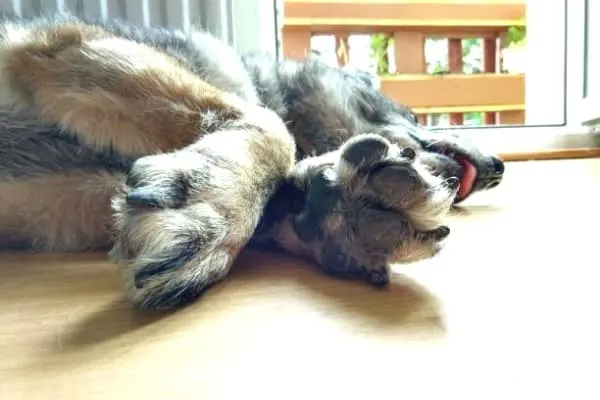
Which grip should you use on your German Shepherd’s paw?
There are a few different grab techniques you can utilize to help you cut your dog’s nails. Work as efficiently as you can so the task is over quickly.
Many people are most comfortable facing their Shepherd while trimming his nails or examining his ears.
If you have collected all of your tools, your dog probably knows what is coming.
Nevertheless, unless your dog does not care about nail trims, run your hand down the shoulder and leg before grasping the paw.
Do the same at the hind end from above the hock to the lower leg. Avoid unceremoniously grabbing your dog’s leg.
Grip the paw firmly in your hand so you can secure the toes. If your dog will tolerate it, you can provide additional stability by holding each toe between finger and thumb as you trim the nail.
Many dogs object to you holding the toes, so you can alternatively cradle the bottom of the paw against your palm and let the nails hang over the edge of your hand.
Another means of approach is to stand at your dog’s shoulder for the front paws or hip for the rear. Grip the joint above the foot and turn it over so you can see the pads.
Assuming a position behind the head gives you more control over the paw without using force, and it is more awkward for your dog to try to snap at your hand.
This video shows the handler’s stance at Shepherd’s shoulder and hip, turning the paw backward.
Many Shepherds will not be so cooperative, but this is an example of a dog who does well on the ground level. The owner is using plier-type nail clippers.
When you hold the paw or the metacarpus or metatarsus (joints above paws), try to stay as close to your dog’s body as you can.
You see many images where a handler is pulling a dog’s paw forward like an extended handshake.
Instead, lift the paw upwards, allowing your GSD to hold it at a natural angle for her elbow or knee.
That way you do not stress the shoulders, elbows, hips, and toes because as you tug, your dog will tend to yank against you.
If your German Shepherd cannot stand having his feet touched, try cutting the nails when he has planted his paws on the table.
You can hold the paw down at the pastern with one hand and cut the nail with the other. The claw should sit slightly above the table’s surface.
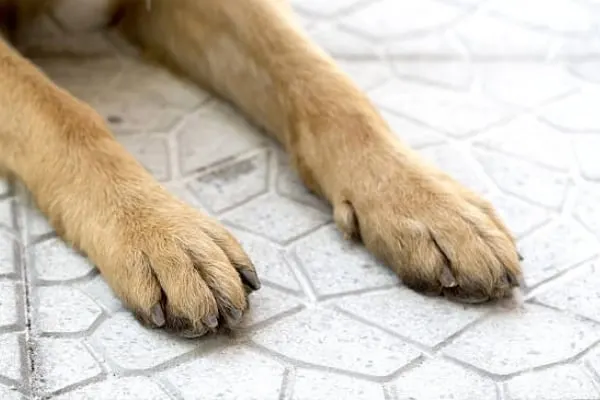
How do you cut black nails?
Black and bi-colored claws are the same as white nails except you cannot easily visualize the quick.
On smaller dogs and puppies, the nails often come to a point that you can easily distinguish from the base.
Regardless of the color of the nail, you can readily snip the ends.
Adult Shepherds have thick nails that have no evidence of tapering. If your dog has a couple of white nails, you can estimate where to cut on the black claws.
If all the nails are black, you have a few options.
You can barely cut a little off the edges on a regular schedule. If your Shepherd exercises as he should, this minor nail trim will be all he needs.
Do not neglect the dewclaw because it never reaches the ground.
Another alternative is to cut gradually and look at the nail head-on as you trim it. You will be able to tell when you are getting close to the quick.
If you accidentally make a nail bleed, you know where the quick is. We recommend avoiding cutting the quick at all costs.
Finally, you can simply have your veterinarian clip your Shepherd’s nails every six to eight weeks, or hire a professional groomer and get a bath for your dog at the same time.
When should you seek professional help to clip your GSD’s nails?
Now and then, nail trims become complicated and you may need to seek medical intervention.
Fractious Shepherds
If you attain your German Shepherd as an adult, you may not have a chance to socialize her to the point where she will tolerate you clipping her nails.
Other times, a dog will not let you touch her feet no matter how much you try to accustom her to it as a puppy.
If your Shepherd is intolerant of you trimming his nails at home, seek the help of your veterinarian.
German Shepherds are large and powerful and every altercation over nails is likely to escalate.
Fighting with your Shepherd could go wrong in so many ways. Your dog could not only bite you, but you might compromise your bond with your GSD.
Moreover, a physical fight is not one you will win against your dog without inflicting bodily harm.
Your dog either will behave paradoxically better with strangers like a veterinary technician or groomer, or the medical team will know how to properly and safely restrain your pet.
They also have access to sedation as a last resort. Keep your relationship with your Shepherd intact.
Health Problems
If your Shepherd has always been cooperative with nail trims and suddenly becomes reluctant or fights you, it may be time to visit your veterinarian.
Your dog might suffer from a painful joint or a problem with a claw.
- Infection – fungus or bacteria
- Autoimmune disease – Lupus
- Trauma – Nails can fracture across portions of the quick and are quite painful. Your veterinarian will cut above the fracture, stop the bleeding, and possibly bandage the foot.
- Abnormal nail growth – Older dogs, especially, tend to grow longer claws. Neglected feet can see the nails curl and grow into the pads. Nail clipping requires medical attention as the veterinarian may have to anesthetize your dog for pain-free claw removal. Your GSD may also need antibiotics.
- Vitamin or mineral deficiency – Nails may become brittle and crack. If you feed your Shepherd a raw diet, for example, make sure to coordinate nutritional balance with your vet.
Nail problems, like any foot issues, can manifest as your Shepherd excessively licking the paw or lameness, swelling, and redness.
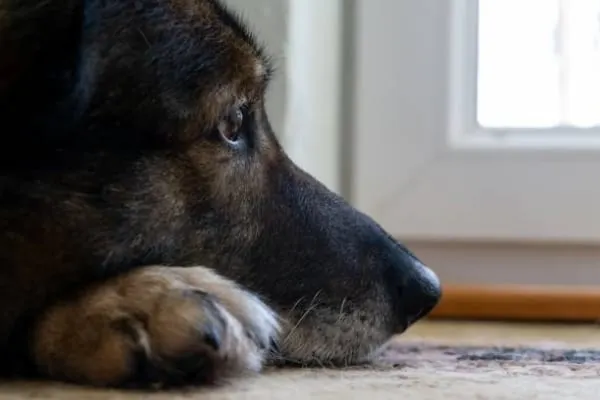
Summary
Regular nail trims every 6 to 10 weeks is the most effective way to prevent problems from overgrown claws in German Shepherds.
It is also a fantastic opportunity for you to examine your dog’s foot.
Feet are sensitive areas for pets, so approach with plenty of preparation, patience, and coaxing.
Time nail trims for when your German Shepherd is in a relaxed and cooperative state of mind.
Recommended reading:
- 7 Best Shampoo For German Shepherd
- 5 Best Dog Brushes For German Shepherds
- 7 Best Grooming Tools For A German Shepherd

























